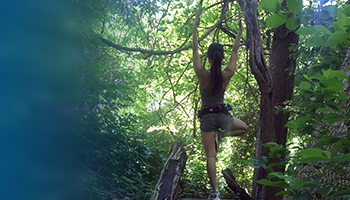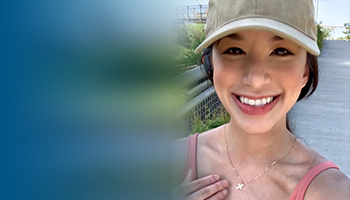HOW CAN WE HELP YOU? Call 1-800-TRY-CHOP
In This Section
Take a Break and Breathe

Science writer, Jill Lim, is training to be a yoga instructor.
georges [at] email.chop.edu (By Sharlene George)
Editor’s Note: Our seasonal “Off Campus” series on Cornerstone is back. Last summer, we shared fun stories and photos about our colleagues and what they do to de-stress and reset. Get to know your colleagues — even if you’re working remotely! Learn who among us is an avid skier, tango dancer, bird watcher, baker, and more. These easy-to-read stories help us connect with each other in new ways and build community, particularly now during the coronavirus pandemic. If you know of someone with an unusual hobby or interest in your department or lab, the Research Creative Services writers want to hear from you. Or nominate yourself! Send us an researchcomm [at] email.chop.edu (email). Maybe you’ll be our next “Off Campus” celebrity.
On days when the world seems to have turned sideways, Jill Lim, a Research Creative Services science writer, turns to practicing yoga to recenter.
“Yoga and breath work help sift through whatever negative or stressful emotions you're feeling,” Lim said. “You can steer away from what might be an anxious fight or flight response to the events in the world and create that safe space in your mind that is always available to you.”
Lim began taking yoga and Pilates classes as an undergraduate student in Canada for a little exercise. She enjoyed concentrating on balancing the poses, while at the same time letting go of tension. When she moved to New York to pursue her master’s degree in Science, Health, and Environmental Reporting at New York University, a free yoga studio nearby became her oasis from the fast pace and pressure.
In 2017, Lim brought her passion for yoga and for science writing to CHOP Research Institute. She interviews up-and-coming scientists and renowned researchers and then writes stories for the Cornerstone blog to highlight how their innovation and ingenuity translate into solutions for most challenging pediatric health problems. Lim also manages the Research Institute’s social media channels and connects with followers through engaging and informative tweets, posts, and pics.
Staying on top of the Research Institute’s world-changing work is both challenging and rewarding. Before jumping into her workdays, Lim would visit a yoga studio around the corner from her Center City apartment. There she learned that yoga offered much more than fitness and calm — it inspired her to practice kindness to herself and others.
“The teachers I met at the Philadelphia studio were so compassionate, loving, and caring,” Lim said. “They were inspiring, and I decided to train to become a yoga instructor.”
Lim has a few more hours to go to complete her teacher training. She mostly practices the vinyasa, yin, and restorative styles of yoga. Vinyasa, sometimes also called “flow” or “Vinyasa Flow,” is dynamic and rhythmic, linking breath and movement. Yin yoga is a slower pace that holds poses for three to five minutes. Restorative yoga emphasizes relaxation and flexibility to nurture, heal, and relieve your body of stress.

Jill Lim taught her Research Creative Services colleagues via video meetings how to de-stress in their at-home workspaces.
When the studio closed during the COVID-19 shelter-in-place recommendations, Lim set aside time on Tuesday mornings to teach her Research Creative Services colleagues via video meetings how to de-stress at their desks in their at-home workspaces. They practiced an easy and versatile three-part breathing technique that involves visualizing the three parts of your body’s trunk — the abdomen, lower ribs, and upper chest — and then breathing into those three parts.
“First, sit up straight, and lengthen your spine,” Lim explained. “Keep your shoulders and your chest open. It helps to place one hand on your belly and the other on your upper chest. Take a slow, deep inhale — deeper than you usually would breathe. Inhale into the belly, the ribs, the chest, and hold at the top all the way up to your nose. Then exhale through your mouth. It should feel like a sigh. Visualize yourself releasing stress or worries. You can repeat this for five rounds or so, and also try it lying down, to get into a more relaxed state.”
Taking five or 10 minutes to find a little breathing room for yourself is a simple way to settle your mind and lean into your body, especially during these complicated times, Lim said. In addition to her breathing tips, she shared a favorite quote to focus on when life is feeling out of control: “Let the intelligence of your mind bow to the wisdom of your body.”


